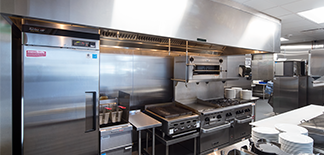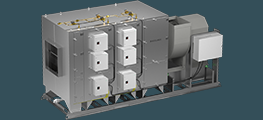THIS WHITE PAPER WILL ADDRESS:
- Understanding Grease Extraction
- Filtered versus Electrostatic Pollution Control
- Smoke and Odor Removal
- Pollution Control Safety
THE GREASE ISSUE
Grease production in a kitchen is a near guarantee, as any cooking operation with fats, oils, or meat can and will release grease into the exhaust airstream. Codes, such as the International Mechanical Code (IMC) demand certain safety requirements in commercial kitchen hoods to mitigate the risks associated with grease build-up. Such safety requirements include automatic fan controls, a fire suppression system to put out any fire under the hood, and grease filters within the hood.
Hood-installed grease filters are the first line of defense against grease buildup throughout the remainder of the kitchen ventilation system. Most high efficiency kitchen hood filters can remove the majority of large (>8 micron) grease particles generated through cooking. However, most appliances will be producing particles with a wide range of sizes, anywhere from submicron to 10 microns or larger. The size distribution of these particles generated during cooking is highly dependent on the appliance used and the food being cooked. For example, higher temperature appliances, like broilers, not only produce higher amounts of particulate, but a greater percentage of smaller particles, see ASHRAE RP-745 for more information. Unfortunately, hood filter efficiency generally decreases when subjected to smaller grease particles. While typical high efficiency hood filters remove upwards of 90% of particles at 8 microns or larger, they may only capture around 10% (or less) of grease at 1 micron and below. Knowing hood filters may lack a desired efficiency level with these smaller particles, how are kitchens meant to reduce their level of emissions in locations where air pollution management is critical?
Pollution control units (PCU) are secondary filtration devices, installed inline to the grease duct, which are designed specifically for commercial kitchen systems to capture the remaining grease particles from the airstream. These units utilize various filtration techniques, usually to achieve a certain level of air quality, or to allow sidewall exhaust (or similar) in areas where vertical exhaust would be ill-advised.
POLLUTION CONTROL UNITS
With the increasing size of the urban landscape, the focus on clean air, and the rise of multi-use buildings, restaurant grease and odor control play an increasingly important role in commercial kitchen exhaust systems. Pollution control units are specifically designed to eliminate both grease and smoke particles from a kitchen exhaust system, utilizing one of two methods of filtration to remove most particles even below 1 micron in size. Furthermore, be aware of listings, as recent code revisions are requiring a UL 8782 or equivalent safety listing on pollution control units.
- FILTERED POLLUTION CONTROL: Mechanically filtered pollution control units utilize multiple stages of increasingly efficient filters to handle the kitchen exhaust air. These mechanically filtered units rely on traditional MERV or HEPA style filters, which load over time and need to be replaced once saturated. Maintenance, or filter replacement frequency, depends on the style of cooking done in the kitchen, the type of appliances used to do the cooking, and the efficiency of filtration done prior to the airstream reaching the PCU. The mechanical filter-style PCU is typically best paired with lighter duty equipment, as heavy or solid fuel appliances tend to rapidly load the filters in the unit, dramatically increasing operational costs.
- ELECTROSTATIC POLLUTION CONTROL: Electrostatic Precipitator (ESP) units filter the air using electrostatic cells. Electrostatic cells operate by applying a charge to the airborne particles as they pass through each electrostatic cell. Those particles, now ionized, pass over charged plates, where the electric force between the positive particles and the negative plates causes the charged grease and smoke particles to naturally collect upon the plates. As the cells are metal, they can be washed, and most ESP PCU’s feature automatic wash systems, which clean the units regularly, removing the burden of manual maintenance. This PCU style is more common for high grease and smoke producing systems due to its higher efficiency and self-cleaning functionality, reducing maintenance demands and overall operational costs.
SMOKE & ODOR REMOVAL
Grease is not the only thing produced when cooking, smoke and odor are also given off from the appliances. Smoke, while more common on heavier duty equipment, is released as very fine particles, well below 1 micron in size. Because those smoke particles are so fine, they can pass more readily through the mechanical filters in the filtered PCU’s. On the other hand, electrostatic PCU’s are much more effective at removing smoke from the exhaust stream, because particle size doesn’t play as large of a role in this non-mechanical filtration.
Smells, savory or not, are almost always produced as a byproduct of cooking and exists at even smaller particle sizes than smoke. While odor levels are generally reduced as grease is removed, residual odorous molecules will still stay in the airstream, or reside as vapor, too small for either mechanical or electrostatic filtration methods to capture. PCU’s commonly feature additional sections of filtration after the primary filtration method within the PCU, specifically for the capture of any residual odors. This additional filtration section commonly utilizes carbon or carbon blended filters but may also use alternate methods.
Carbon filters uniquely remove odor from the air stream. Instead of the filter media blocking particles past a certain size, carbon removes odor through adsorption. Adsorption is the process in which molecules are pulled from the air and rest on the surface of an adsorbent, such as carbon in this instance. The surface of activated carbon is covered with very small pores which attract odor molecules to stick to the carbon. However, as those carbon pores fill up, odor reduction will decline, and that filter will eventually need to be replaced.
Another, less common, method of handling odor from cooking in PCU’s is through masking, where a deodorizing spray is applied to the airstream to cover up the original cooking odor with an alternative, instead of eliminating the odor itself.
One style of cooking that produces high levels of smoke and odor is solid fuel, which uses wood or charcoal. Solid fuel appliances generally produce the largest amounts of smoke and odor, so it is imperative to not only have a PCU ready to handle the volume of contaminants but are also able to filter out the smoke and odor associated with solid fuel cooking. With solid fuel, it is more common to use an electrostatic PCU instead of a mechanically filtered unit, mostly due to the additional filtration levels offered by this type of PCU, specifically when it comes to smoke. Furthermore, because of the large amounts of grease, filtered PCU’s will load up rapidly, demanding frequent filter changes, driving up maintenance costs. Most ESP PCU’s include an auto wash system. This is especially beneficial in solid fuel applications, since these appliances stay hot well after the cooking is completed and the ESP auto cleaning can be scheduled well into the night.
POLLUTION CONTROL SAFETY
There have been relatively few codes dictating pollution control unit construction and required safety features. However, with an increase in demand and application of these units code is rapidly adapting. The requirement for a PCU listing will vary depending on which year of IMC is adopted in a specific locality. For states adopting IMC 2018, PCU’s in kitchen spaces are to be listed and labeled in accordance with UL 1978. However, for states planning to adopt IMC 2021, the newly updated and required listing for PCU’s is UL 8782. For all previous versions of IMC, while there are not any listed UL requirements for PCU’s, it is recommended to still prioritize the previously mentioned UL 8782 listing to ensure increased safety and reliability. These listings and others are discussed below:
- UL 300 LISTED FIRE PROTECTION: Per IMC 2018 and beyond, pollution control units are to be fitted with a fire suppression system, like a kitchen hood, to suppress any fire within the unit. While the UL 300 listing is not called out specifically in the code – most PCU fire systems will carry this listing, ensuring a reliable and safe suppression system.
- UL 762 LISTED EXHAUST FAN: Another new addition in IMC 2018, pollution control units must be fitted with a UL 762 grease rated exhaust fan. With pollution control units, it is important to consider the additional static pressure the PCU contributes before sizing the exhaust fan.
- UNIT LISTING – UL 1978, UL 710: Most PCU’s will advertise a UL listing associated to the unit. However, the actual UL listing the unit was tested to may vary from one manufacturer to the next. UL 710 and UL 1978 are the two most common listings, to date, used for pollution control units. However, neither of these listings are pollution control specific. UL 710 is a kitchen hood listing, meant to prove that a kitchen hood can capture the exhaust given off by appliances throughout cooking. UL 1978 is a grease duct listing, meant to show that grease ductwork will not fail under extreme conditions. A more rigorous test, the pollution control unit is brought to extreme temperatures and must prove its durability.
- UNIT LISTING – UL 8782: Specifically intended for PCU’s, UL 8782 adopted many of the same testing requirements already defined within UL 1978, while adding additional, PCU specific guidelines, and is now required on all PCU’s, per IMC 2021.
At Accurex, we believe there is a better way to help simplify the most challenging kitchen ventilation system environments, from engineering to aftermarket support. As a Greenheck Group Company, we have more than 70 years of manufacturing and engineering experience in air movement and control products and offer a breadth of configurable products and services tailored to meet your needs.
For additional information or questions, please reach out to us at SALES@ACCUREX.COM







